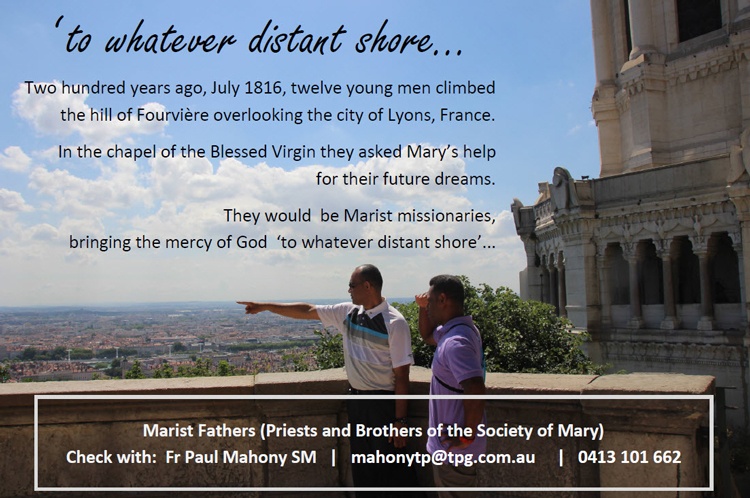A good place to start is with the statement that lit the fire in Fr Colin’s heart. Fr Jean Claude Courveille shared with Colin and some other seminarians words he said he had ‘heard’ on 15 August 1812 in the cathedral of Le Puy: ‘Marie dans l’église naissante et à la fin des temps’. He attributed those words to Mary. The French is generally translated as “Mary in the newborn Church/the Church at its birth and at the end of time.” There are various versions. We should note, however, that ‘lÉglise naissante’ literally means ‘the Church in the process of being born’.
The idea contained in these words – Mary being there, supporting the Church at the beginning and as it comes to birth until the end of time – became foundational for Fr Colin. Jean Coste SM says the expression, ‘I was the support of the newborn church; I shall be so as well at the end of time’ is the one which Father Colin repeated most often, most consistently and most regularly during his whole life. (Cited by Michael Fitzgerald, “A Marian Consciousness,” Maristica, Textus et Studia 5, 22.)
For example:
- …. our model, our only model, must be and was the early Church. And the blessed Virgin, who then did such great things, will do still greater ones at the end of time, …” (A Founder Speaks, 117:2f.)
- The Society must begin a new Church over again. (A Founder Speaks, 120:1)
- I am pleased to be able to repeat it here once again: I supported the Church at her birth: I shall do so again at the end of time. These are the words which served us as a foundation and as an encouragement at the very beginning of the society. (A Founder Speaks, 152:1)
These days we have become familiar with the idea of change and the fluidity of our lives and the institutions of which we are part, including the Church. At the Second Vatican Council, we began to hear the Church spoken of as a “pilgrim Church” (see Dogmatic Constitution on the Church (Lumen Gentium), Chapter VII). There we are reminded that “the Church (is) always in need of being purified, always follows the way of penance and renewal” (#8). We are “as pilgrims in a strange land” (#7).
“l’Église naissante” …. “The Church-being-born” …. “The Pilgrim Church”. In the thinking of Fr Colin, the Church is a creation of God always coming to be. The Mary we discover in Luke’s Gospel fits this picture perfectly:
- You see before you the handmaid of the Lord, let it happen according to your word. (Luke 1:38).
- As for Mary, she treasured all these things and pondered them in her heart. (Luke 2:19).
Pope Francis writes:
- Mary is the woman of faith, who lives and advances in faith, and ‘her exceptional pilgrimage of faith represents a constant point of reference for the Church’. Mary let herself be guided by the Holy Spirit on a journey of faith towards a destiny of service and fruitfulness. (Evangelii Gaudium, #287.)
The Scriptures and the words of Pope Francis suggest a wonderful paradox in the idea of “l’Église naissante”. Mary is on a journey with, in and for the Church as it comes to birth in different places at different times in different ways down the ages. She is fully identified with the Church’s mission – the Church as mission. Mary is also the contemplative. She is able to be still and wait in the obscurity of Nazareth. She engages in deep listening, ready to “let it happen according to God’s word”. She is ready for mission because she listens and hears. Mary was with that first group that “joined in continuous prayer” (Acts 1:14). She was there with them “when Pentecost day came around” (Acts 2:1).
And so we are led to the significance of Mary’s presence with the first disciples. Nazareth, in particular, came to signify for Fr Colin, Mary’s way of being present in support of the Church during those early years.
